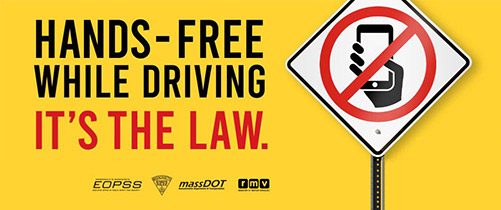
Share this Article
Are You Ready for Hands-Free Driving Laws?
By Rich Weston
Legislation banning the use of electronic devices while driving takes effect Sunday February 23. And though the name is confusing — you should keep your hands on the wheel — the rules are simple: put down your cell phone. From now on, operators of motor vehicles and bicycles are prohibited from using any electronic device, including mobile phones, unless it is used in hands-free mode. Fines will be substantial. A third and subsequent offense will cost $500, plus an insurance surcharge and mandatory completion of a distracted driving educational program.
After 17 years of debate, this law was passed last November, bringing Massachusetts in line with all four of our neighboring states and Vermont.
Here are the rules for drivers who are over 18:
• Use of cell phones must be in hands-free mode. Drivers are only permitted to touch devices to activate hands-free mode.
• Drivers are not permitted to hold or support any electronic device/phone.
• Devices must be installed or properly mounted to the windshield, dashboard, or center console in a manner that does not impede the operation of the motor vehicle.
• Touching your device for texting, emailing, apps, video, or internet use is not allowed .
• Activation of GPS navigation is still permitted when the device is installed or properly mounted.
• Handheld use is not allowed at red lights or stop signs.
• Voice to text and communication to electronic devices is legal only when device is properly mounted. The use of headphone (one ear) is permitted.
For more information, see Mass.gov’s hands-free driving law pamphlet.
Distracted driving is a major cause of motor vehicle crashes. In 2014 the New England Journal of Medicine studied the relationship between the performance of secondary tasks, including cell-phone use, and the risk of crashes and near-crashes. The risk of a crash or near-crash among novice drivers increased significantly if they were dialing a cell phone, reaching for a cell phone, sending or receiving text messages, reaching for an object other than a cell, looking at a roadside object, or eating. Among experienced drivers, dialing a cell phone was associated with a significantly increased risk of a crash or near-crash and although not covered in this study the risks of texting while driving is dire. According to the National Safety Council, every day at least nine people die and 1,000 are injured in distracted driving crashes.
If you have questions on how this might impact your commercial policy, feel free to give me a call at 781.434.7390. We will be watching this to see how these rules impact commercial auto policies and will continue to keep you updated.
Richard Weston, CIC, is a Senior Account Executive at PIAM and has been with the company since 2002. He has been in the commercial insurance sector since 1988 and can assist with a wide range of insurance issues that impact physician practices. If you have questions about insurance or would like Richard to do a full review of your insurance policies and exposures, he can be reached at 781 434-7390 or by email at rweston@mms.org.





